Synthesis of 2,2,5-Trisubstituted Tetrahydrofurans by Ferrocenium-Catalyzed Dehydrative Diol Cyclization Reactions
Abstract
1. Introduction
2. Results and Discussion
3. Experimental Section


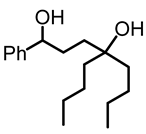
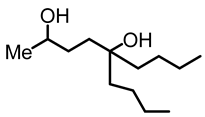




4. Conclusions
Supplementary Materials
Author Contributions
Funding
Data Availability Statement
Conflicts of Interest
References
- Fernandes, R.A.; Pathare, R.S.; Gorve, D.A. Advances in Total Synthesis of Some 2,3,5-Trisubstituted Tetrahydrofuran Natural Products. Chem. Asian J. 2020, 15, 2815–2837. [Google Scholar] [CrossRef] [PubMed]
- De La Torre, A.; Cuyamendous, C.; Bultel-Poncé, V.; Durand, T.; Galano, J.M.; Oger, C. Recent advances in the synthesis of tetrahydrofurans and applications in total synthesis. Tetrahedron 2016, 72, 5003–5025. [Google Scholar] [CrossRef]
- Fernandes, R.A.; Gorve, D.A.; Pathare, R.S. Emergence of 2,3,5-trisubstituted tetrahydrofuran natural products and their synthesis. Org. Biomol. Chem. 2020, 18, 7002–7025. [Google Scholar] [CrossRef] [PubMed]
- Lorente, A.; Lamariano-Merketegi, J.; Albericio, F.; Álvarez, M. Tetrahydrofuran-Containing Macrolides: A Fascinating Gift from the Deep Sea. Chem. Rev. 2013, 113, 4567–4610. [Google Scholar] [CrossRef] [PubMed]
- Nakata, T. Total synthesis of marine polycyclic ethers. Chem. Rev. 2005, 105, 4314–4347. [Google Scholar] [CrossRef]
- González-Andrés, P.; Fernández-Peña, L.; Díez-Poza, C.; Barbero, A. The Tetrahydrofuran Motif in Marine Lipids and Terpenes. Mar. Drugs 2022, 20, 642. [Google Scholar] [CrossRef]
- Kang, E.J.; Lee, E. Total Synthesis of Oxacyclic Macrodiolide Natural Products. Chem. Rev. 2005, 105, 4348–4378. [Google Scholar] [CrossRef]
- Jung, J.H.; Lee, E. Expedient Synthesis of (−)-Amphidinolide X. Angew. Chem. Int. Ed. 2009, 48, 5698–5700. [Google Scholar] [CrossRef]
- Wolfe, J.P. Palladium-Catalyzed Carboetherification and Carboamination Reactions of γ-Hydroxy-and γ-Aminoalkenes for the Synthesis of Tetrahydrofurans and Pyrrolidines. Eur. J. Org. Chem. 2007, 571–582. [Google Scholar] [CrossRef]
- Fernandez de la Pradilla, R.; Montero, C.; Priego, J.; Martínez-Cruz, L.A. A Novel Sulfoxide-Directed Route to Enantiopure Tetrahydrofurans: Application to the Expedient Formal Synthesis of (+)-trans-Kumausyne and (+)-Kumausallene. J. Org. Chem. 1998, 63, 9612–9613. [Google Scholar] [CrossRef]
- Zhou, Y.; Xu, X.; Sun, H.; Tao, G.; Chang, X.Y.; Xing, X.; Chen, B.; Xu, C. Development of highly efficient platinum catalysts for hydroalkoxylation and hydroamination of unactivated alkenes. Nat. Commun. 2021, 12, 1953. [Google Scholar] [CrossRef] [PubMed]
- Jalce, G.; Franck, X.; Figadère, B. Diastereoselective synthesis of 2,5-disubstituted tetrahydrofurans. Tetrahedron Asym. 2009, 20, 2537–2581. [Google Scholar] [CrossRef]
- Čorić, I.; Kim, J.H.; Vlaar, T.; Patil, M.; Thiel, W.; List, B. Brønsted acid catalyzed asymmetric SN2-type O-alkylations. Angew. Chem. Int. Ed. 2013, 52, 3490–3493. [Google Scholar] [CrossRef] [PubMed]
- Olah, G.A.; Fung, A.P.; Malhotra, R. Synthetic Methods and Reactions; 99. Preparation of Cyclic Ethers over Superacidic Perfluorinated Resinsulfonic Acid (Nafion-H) Catalyst. Synthesis 1981, 474–476. [Google Scholar] [CrossRef]
- McCullough, L.R.; Childers, D.J.; Watson, R.A.; Kilos, B.A.; Barton, D.G.; Weitz, E.; Kung, H.H.; Notestein, J.M. Acceptorless dehydrogenative coupling of neat alcohols using group VI sulfide catalysts. ACS Sustain. Chem. Eng. 2017, 5, 4890–4896. [Google Scholar] [CrossRef]
- Nalesnik, T.E.; Holy, N.L. Homogeneous catalytic cyclization and oxidation of diols. J. Org. Chem. 1977, 42, 372–374. [Google Scholar] [CrossRef]
- Aricò, F.; Tundo, P.; Maranzana, A.; Tonachini, G. Synthesis of five-membered cyclic ethers by reaction of 1,4-diols with dimethyl carbonate. Chem. Sustain. Chem. 2012, 5, 578–1586. [Google Scholar] [CrossRef]
- Mihailović, M.L.; Gojković, S.; Čeković, Ž. Stereochemistry of cyclic ether formation. Part I. Stereoselective intramolecular cyclisation of aliphatic disecondary 1,4-diols and their sulphonate esters to tetrahydrofurans. Perkin Transactions. J. Chem. Soc. 1972, 2460–2464. [Google Scholar] [CrossRef]
- Jacobus, J. Mechanism and stereochemistry of 1,4-diol ring closure to tetrahydrofuran. J. Org. Chem. 1973, 38, 402–404. [Google Scholar] [CrossRef]
- Sutro, J.L.; Fürstner, A. Total Synthesis of the Allenic Macrolide (+)-Archangiumide. J. Am. Chem. Soc. 2024, 146, 2345–2350. [Google Scholar] [CrossRef]
- Mihelich, E.D. Stereoselective synthesis of highly substituted tetrahydrofurans through acid-catalyzed ring closure of selenyl diols. J. Am. Chem. Soc. 1990, 112, 8995–8997. [Google Scholar] [CrossRef]
- Alvarez-Manzaneda, E.J.; Chaboun, R.; Alvarez, E.; Cabrera, E.; Alvarez-Manzaneda, R.; Haidour, A.; Ramos, J.M. Cerium (IV) ammonium nitrate (CAN): A very efficient reagent for the synthesis of tertiary ethers. Synlett 2006, 1829–1834. [Google Scholar] [CrossRef]
- Sharma, G.V.M.; Kumar, K.R.; Sreenivas, P.; Krishna, P.R.; Chorghade, M.S. Catalytic FeCl3-or Yb(OTf)3-mediated synthesis of substituted tetrahydrofurans and C-aryl glycosides from 1, 4-diols. Tetrahedron Asym. 2002, 13, 687–690. [Google Scholar] [CrossRef]
- Anastas, P.; Eghbali, N. Green chemistry: Principles and practice. Chem. Soc. Rev. 2010, 39, 301–312. [Google Scholar] [CrossRef]
- Bauer, I.; Knölker, H.-J. Iron catalysis in organic synthesis. Chem. Rev. 2015, 115, 3170–3387. [Google Scholar]
- Rana, S.; Biswas, J.P.; Paul, S.; Paik, A.; Maiti, D. Organic synthesis with the most abundant transition metal–iron: From rust to multitasking catalysts. Chem. Soc. Rev. 2021, 50, 243–472. [Google Scholar]
- Wei, D.; Darcel, C. Iron catalysis in reduction and hydrometalation reactions. Chem. Rev. 2018, 119, 2550–2610. [Google Scholar] [CrossRef]
- Bauer, E.B. Recent Catalytic Applications of Ferrocene and Ferrocenium Cations in the Syntheses of Organic Compounds. Molecules 2024, 29, 5544. [Google Scholar] [CrossRef]
- Toma, Š.; Šebesta, R. Applications of ferrocenium salts in organic synthesis. Synthesis 2015, 47, 1683–1695. [Google Scholar] [CrossRef]
- Fiolek, T.J.; Keel, K.L.; Tepe, J.J. Fluspirilene analogs activate the 20S proteasome and overcome proteasome impairment by intrinsically disordered protein oligomers. ACS Chem. Neurosci. 2021, 12, 1438–1448. [Google Scholar] [CrossRef]
- Too, P.C.; Tnay, Y.L.; Chiba, S. Copper-catalyzed aerobic aliphatic C–H oxygenation with hydroperoxides. Beilstein J. Org. Chem. 2013, 9, 1217–1225. [Google Scholar] [CrossRef] [PubMed]
- Hashimoto, T.; Hirose, D.; Taniguchi, T. Direct Synthesis of 1,4-Diols from Alkenes by Iron-Catalyzed Aerobic Hydration and C-H Hydroxylation. Angew. Chem. Int. Ed. 2014, 53, 2730–2734. [Google Scholar] [CrossRef] [PubMed]
- Satoh, T.; Yasoshima, T.; Momochi, H. A new approach to the synthesis of 1-oxaspiro [4. n] alkanes and tetrahydrofurans by the 1,5-CH insertion reaction of magnesium carbenoids. Tetrahedron Lett. 2012, 53, 2074–2077. [Google Scholar] [CrossRef]
- Rivero, A.R.; Fodran, P.; Ondrejková, A.; Wallentin, C.J. Alcohol etherification via alkoxy radicals generated by visible-light photoredox catalysis. Org. Lett. 2020, 22, 8436–8440. [Google Scholar] [CrossRef] [PubMed]
- Mo, X.; Yakiwchuk, J.; Dansereau, J.; McCubbin, J.A.; Hall, D.G. Unsymmetrical diarylmethanes by ferroceniumboronic acid catalyzed direct Friedel–Crafts reactions with deactivated benzylic alcohols: Enhanced reactivity due to ion-pairing effects. J. Am. Chem. Soc. 2015, 137, 9694–9703. [Google Scholar] [CrossRef]
- Zaragoza, J.P.T.; Cummins, D.C.; Mubarak, M.Q.E.; Siegler, M.A.; de Visser, S.P.; Goldberg, D.P. Hydrogen Atom Abstraction by High-Valent Fe(OH) versus Mn(OH) Porphyrinoid Complexes: Mechanistic Insights from Experimental and Computational Studies. Inorg. Chem. 2019, 58, 16761–16770. [Google Scholar] [CrossRef]
- Babin, V.N.; Belousov, Y.A.; Belousova, T.A.; Borisov, Y.A.; Gumenyuk, V.V.; Nekrasov, Y.S. Reactions of ferricinium salts with Lewis bases. Russ. Chem. Bull. Int. Ed. 2011, 60, 2081–2087. [Google Scholar] [CrossRef]
- Duarte, F.; Paton, R.S. Molecular Recognition in Asymmetric Counteranion Catalysis: Understanding Chiral Phosphate-Mediated Desymmetrization. J. Am. Chem. Soc. 2017, 139, 8886–8896. [Google Scholar] [CrossRef]
- Mahlau, M.; List, B. Asymmetric Counteranion-Directed Catalysis (ACDC): A Remarkably General Approach to Enantioselective Synthesis. Isr. J. Chem. 2012, 52, 630–638. [Google Scholar] [CrossRef]
- Raskatov, J.A.; Thompson, A.L.; Cowley, A.R.; Claridge, T.D.W.; Brown, J.M. Chiral recognition in contact ion-pairs; observation, characterization and analysis. Chem. Sci. 2013, 4, 3140–3147. [Google Scholar] [CrossRef]
- Burchat, A.F.; Chong, J.M.; Nielsen, N. Titration of alkyllithiums with a simple reagent to a blue endpoint. J. Organomet. Chem. 1997, 542, 281–283. [Google Scholar] [CrossRef]
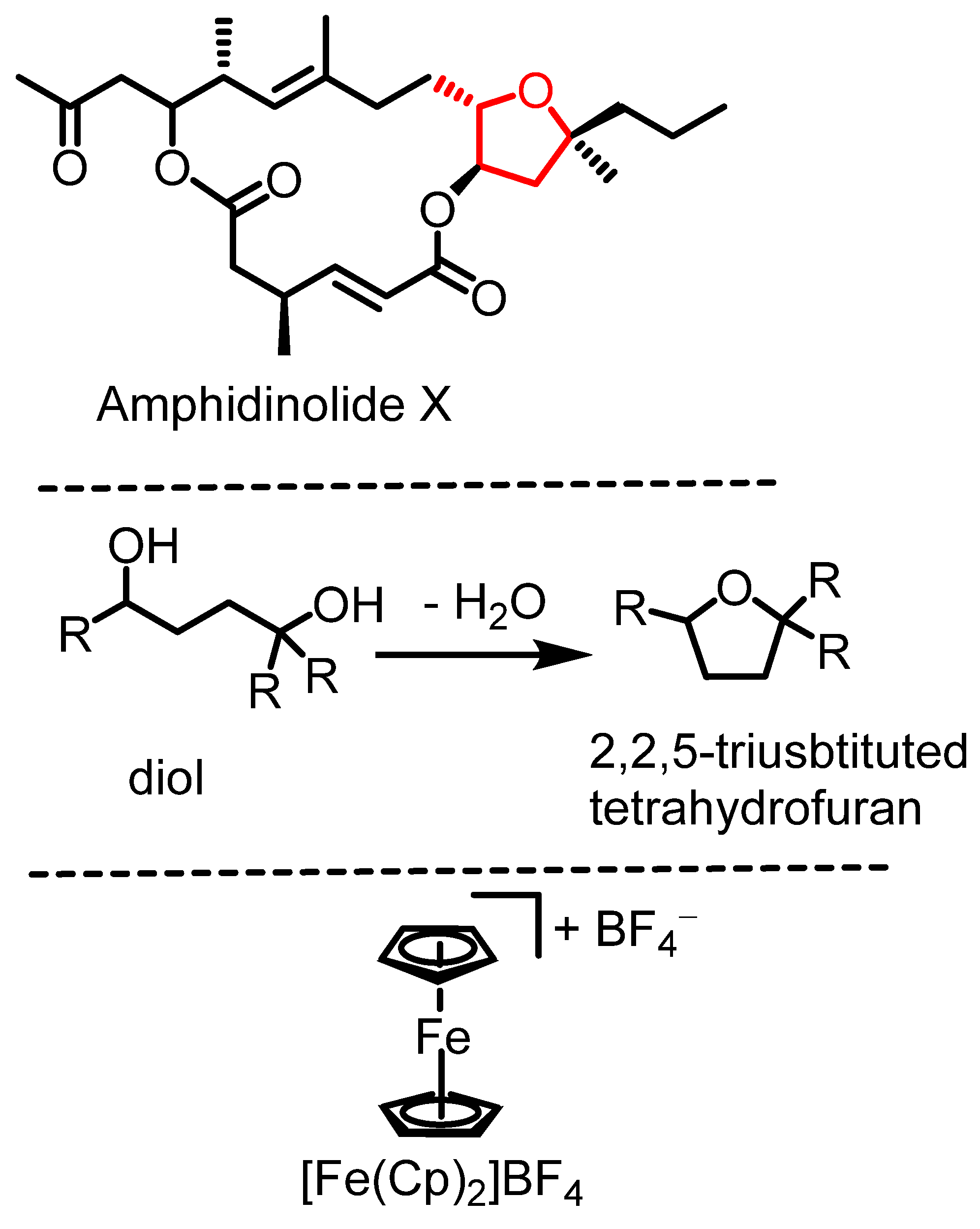
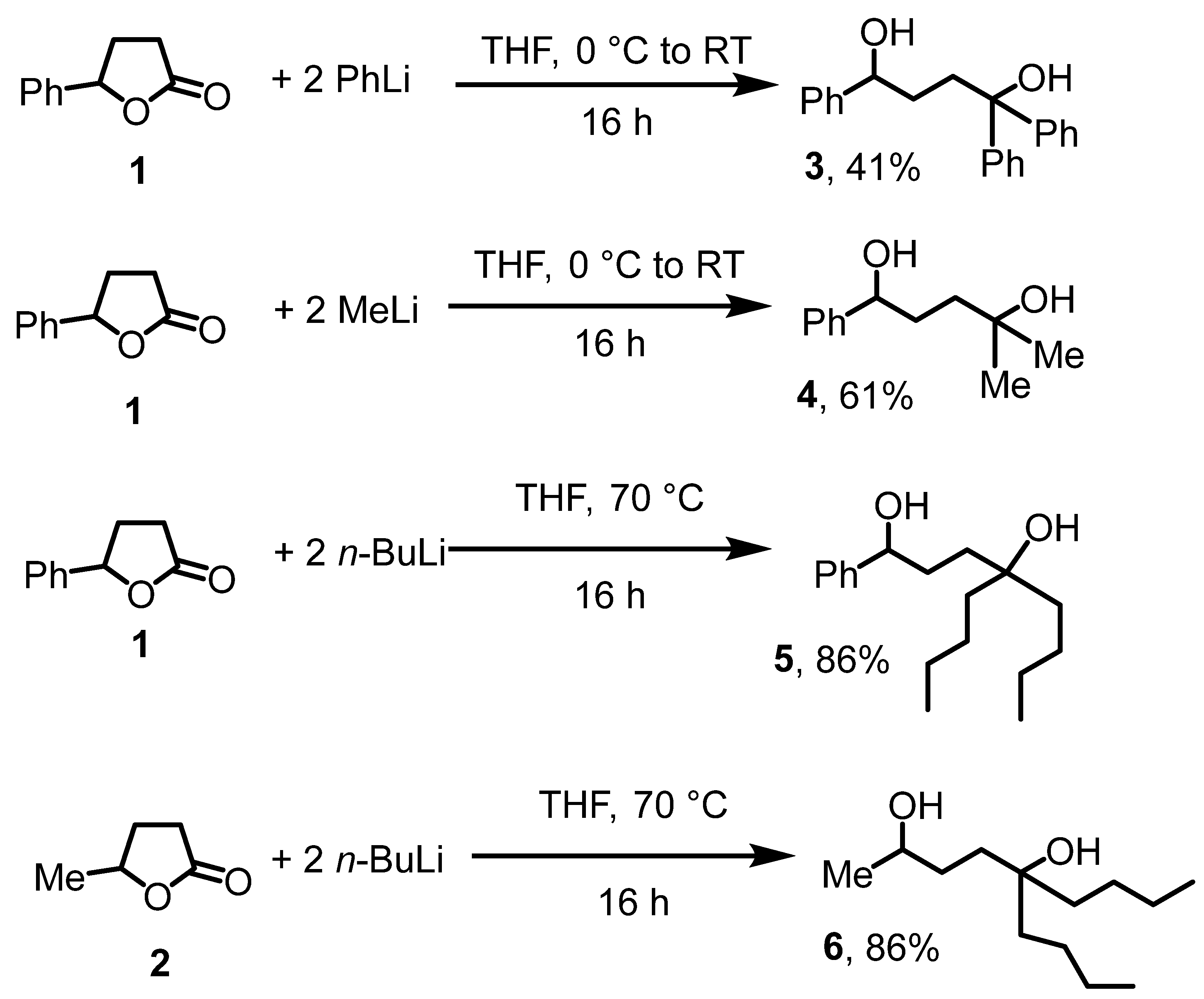

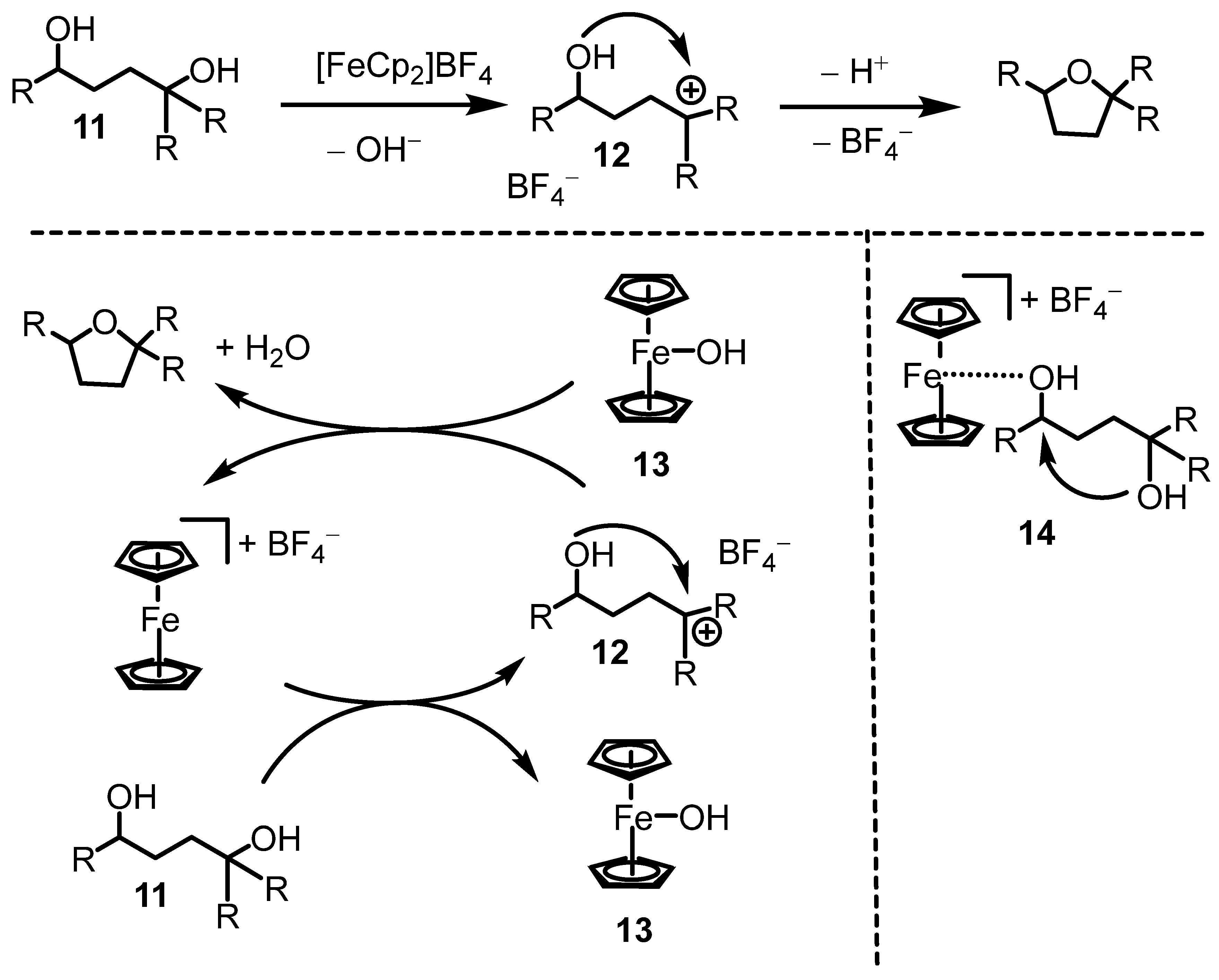
Disclaimer/Publisher’s Note: The statements, opinions and data contained in all publications are solely those of the individual author(s) and contributor(s) and not of MDPI and/or the editor(s). MDPI and/or the editor(s) disclaim responsibility for any injury to people or property resulting from any ideas, methods, instructions or products referred to in the content. |
© 2025 by the authors. Licensee MDPI, Basel, Switzerland. This article is an open access article distributed under the terms and conditions of the Creative Commons Attribution (CC BY) license (https://creativecommons.org/licenses/by/4.0/).
Share and Cite
Amann, C.D.; Khushboo; Bauer, E.B. Synthesis of 2,2,5-Trisubstituted Tetrahydrofurans by Ferrocenium-Catalyzed Dehydrative Diol Cyclization Reactions. Inorganics 2025, 13, 59. https://doi.org/10.3390/inorganics13020059
Amann CD, Khushboo, Bauer EB. Synthesis of 2,2,5-Trisubstituted Tetrahydrofurans by Ferrocenium-Catalyzed Dehydrative Diol Cyclization Reactions. Inorganics. 2025; 13(2):59. https://doi.org/10.3390/inorganics13020059
Chicago/Turabian StyleAmann, Cody D., Khushboo, and Eike B. Bauer. 2025. "Synthesis of 2,2,5-Trisubstituted Tetrahydrofurans by Ferrocenium-Catalyzed Dehydrative Diol Cyclization Reactions" Inorganics 13, no. 2: 59. https://doi.org/10.3390/inorganics13020059
APA StyleAmann, C. D., Khushboo, & Bauer, E. B. (2025). Synthesis of 2,2,5-Trisubstituted Tetrahydrofurans by Ferrocenium-Catalyzed Dehydrative Diol Cyclization Reactions. Inorganics, 13(2), 59. https://doi.org/10.3390/inorganics13020059






